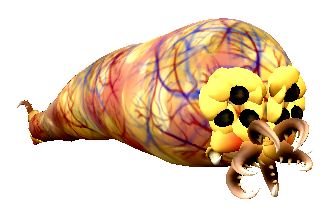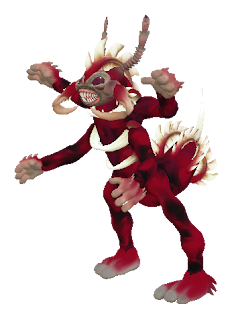Armigo ("Harmy Ant")
No. Enc.: 2d8 (1d8x10)
Alignment: See below
Movement: 120' (40')
—Burrow: 18' (6')
Armor Class: 6
Hit Dice: 6
Attacks: 5 or 1 or 2 (4 claws, 1 bite, or 1 sting, or 2 weapons)
Damage: 1d4 / 1d4 / 1d4 / 1d4 / 1d10, or 1d8 + poison, or by 2 weapons
Save: L6
Morale: 11
Hoard Class: See Below
XP: 570
Armigos are 5' tall, spiky, chitinous insectoids that strike terror into the hearts of all denizens of the Mutant Future. Based on the tales of those few fortunate souls who survived encounters with the dread beings, an insidious pattern emerges.
When Armigos first appear in a region, they are little more than brutes. They mindlessly run roughshod over the landscape and strip it of vegetation and wild game, stinging (and injecting a Class 4 Poison) indiscriminately all the while. They show no interest in material goods [meaning a Hoard Class of None]. They then vanish for a 2d4 weeks...
...but upon reappearing, Armigos evince the rudiments of culture. They construct thatch/mud domiciles, fashion primitive tools, and adorn their bodies with ornaments [gaining Hoard Class V]. At this point, they actively hunt larger prey, including humanoids and other sentients....
And then they vanish again for another 2d4 weeks.
At the end of this duration, and always at the most inopportune time, the Armigos appear again...armed to the mandibles with Ancient weaponry and artifacts [Hoard Classes XV and XVIII], and the wherewithal to use them. They make bombastic, imperious demands of all settlements in a region, and overrun any all who dare oppose them. The militant insects add the residents to their ranks, and march their slave-armies to conquer other communities.
At the end of 1d6 months (and usually after all their press-ganged minions have perished from exhaustion, starvation, battle, or being eaten by their masters), the remaining Armigos vanish...
...and the cycle begins anew.
Mutations: Toxic Weapon (Venom)

















































